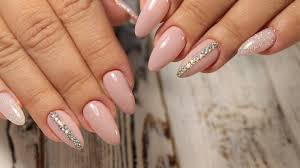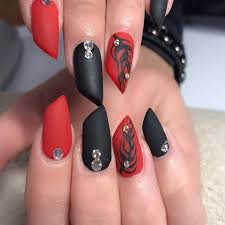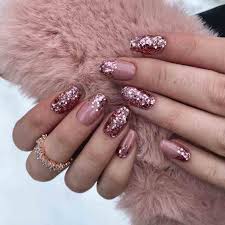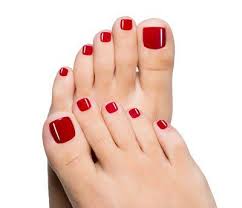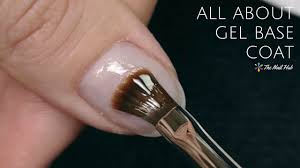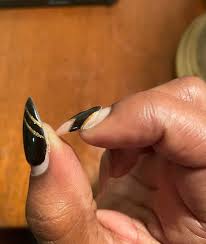
Which One Is Better for Weak Nails?
From my personal experience, gel nails feel more lightweight and natural. They’re applied using a gel-based formula that’s cured under a UV lamp, giving them a shiny, polished look. I found them more flexible and easy to remove than acrylics, which is a big plus if your nails are prone to peeling or bending. On the flip side, acrylic nails are known for their strength and durability. They’re made by mixing liquid and powder—specifically, monomer and polymer—to create a strong paste that’s applied to the nail, then shaped and filed. The mixture hardens to form a durable, protective layer over your nail.
However, I’ve learned that if not maintained well, acrylics can be a bit harsh and may even cause damage, especially to natural nails. That’s why it’s important to understand the key differences, like the unique distinctions in surface, finish, and how each reacts to wear and tear. Before every nail appointment, I now ask my technician for advice, and we decide based on how my nails feel that day. Whether you’re going for a strong look that lasts or something softer and easier on the nail, knowing the real details helps you make the best choice for your nail health.
The specific type of manicure you choose can affect your nail health long term. Gel is known for being long-lasting, but it’s also less strong and not as resistant to chipping or breaking compared to acrylic nails, which are typically thicker, more opaque, and have a more artificial look. However, I’ve noticed that gel feels lighter and allows me to engage in day-to-day tasks without feeling weighed down. While acrylic is undeniably stronger and durable, it can be a bit too hard on weak nails, especially if not maintained well or when fill-ins are missed. On the other hand, gel nails—though prone to cracking if not preserved properly—offer a more comfortable, flexible wear. Both types do require regular maintenance, but the general vibe of gel fits better with an easy-going yet polished style. Many people also wonder how much are french tip nails, especially when choosing between classic styles in gel or acrylic finishes—prices can vary based on the design and salon.
How are gel nails applied?
As someone who’s tried both acrylic and gel nail polish, I’ve noticed that gel feels gentler and more lightweight on weak nails. The process begins by buffing the nails gently and wiping them with alcohol to help the polish adhere better. This simple step prevents lifting and peeling, which is a big win if your nails are prone to breakage. Once prepped, each coat of gel nail polish is applied smoothly and then placed under a UV light—usually for about 30 seconds to two minutes—to cure and dry completely. No waiting around for the polish to set; it hardens right away, leaving a glossy, fresh-looking finish.
From my own experience, gel extensions and natural nails both hold the gel polish really well. It creates a long-lasting effect without the bulkiness of nail extensions. Just keep in mind, UV nail lamps do give off harmful UV rays, so I always apply a good SPF like L’Oreal Paris Bright Reveal Broad Spectrum SPF 50 Daily UV Lotion on my hands and fingers before my manicure. This helps protect the skin from damage while still enjoying a flawless look without worrying about smudging. A helpful tip at nail salon is to always ask your nail artist to use SPF or recommend one before starting, especially if your nails are weak or sensitive. Trust me, taking those few extra minutes makes all the difference when it comes to maintaining healthy, polished nails.
How are acrylic nails applied?
When my own weak nails began chipping no matter what polish I used, I turned to acrylic nails for added strength and length. The process starts by mixing a liquid monomer with a powder polymer to create a thick, gummy paste. This blend is mixed in a small bowl, then carefully applied to the natural nails using a brush. As it meets the air, it hardens, forming a durable, protective layer that can be filed and shaped to your liking. Some technicians use fake nail tips to extend the length, while others sculpt directly on the nail for a more natural look.
The beauty of this method is how customizable it is. Whether you prefer a short shape or desired length, it’s easy to achieve. The paste and mixture are sculpted over the form, then shaped once dry. Depending on the skill of your nail technician, the entire process can take around an hour or more. From my experience, when done right, acrylic overlays can transform fragile nails into beautiful, long-lasting manicures. And trust me, a good set from a pro makes all the difference in achieving a polished look that holds up through daily wear.
Comparison of Acrylic and Gel Nails
When working with weak nails, choosing between acrylic and gel isn’t just about looks—it’s about the health and strength of your natural nails. I’ve handled many manicures for clients with fragile nails, and over time, I’ve learned how critical the application and curing process is. Acrylic nails require the surface of the nail to be made rough, which means heavy filing using files—sometimes even extensive ones. This can cause trauma to the cuticle and lead to pain, especially if the nail becomes chipped or broken. On top of that, the acrylic formula starts to cure when exposed to air, hardening fully in about 15–30 mins.
On the flip side, gel nails are cured under UV light in smooth layer applications. The process feels gentler and more controlled, especially when professionally done. I’ve seen better hygiene outcomes with gels, too. Acrylic removal requires soaking in acetone using cotton, aluminum, and a bowl—a very time-consuming task. This can be especially risky for sensitive skin, increasing the chance of bacterial problems. According to AAD (American Academy of Dermatology), products used in acrylics may irritate some individuals, especially when applied incorrectly.
In terms of style and maintenance, both options have something to offer. Gels usually feel more polished, come in fun colors, and give a smooth, finished look that’s perfect for any event. Gel formulas also work beautifully when you’re aiming for the most attractive nail color, thanks to their glossy appearance and wide selection of finishes. Acrylics can be mold-ed into various shapes and are known for their ultra-strong hold, but they can feel thicker and are sometimes glued on too firmly, which can harm already damaged nails. From a salon perspective, gels are more efficient and easy to maintain, while acrylics need regular filled-in sessions every few weeks to keep them looking fresh. The services you choose, your location, and how well you take care of your nails between visits will also impact the longevity of your manicure.
I’ve seen the trend for chrome and trendy finishes grow over time, especially in high-end salon settings. No matter which option you choose, always make sure your nails are cleaned at the base, your nail tech uses sanitized tools, and your overall hygiene is prioritized. Whether you love the strong hold of acrylic or the natural shine of gel, knowing your nails’ condition and what they can handle is key.

Pros and Cons of Acrylic Nails
Acrylic Nails
Working with acrylic nails over the years, I’ve seen their benefits, especially for people with weak or brittle nails. They’re extremely durable, often lasting six weeks without chipping, peeling, or breakage. They’re also affordable, making them a smart choice for those on a budget, considering the long-term cost. What I love is how customisable they are—you can choose your style, shape, size, and play with different colours and styles to suit your taste and personality. They give a polished, sophisticated look and are easy to maintain with low maintenance, needing little polishing, cleaning, or touch-ups. No wonder they remain a top pick in many manicures.
| Advantages | Disadvantages |
| acrylic, nails, durable, six, weeks, chipping, peeling, break, brittle, weak, affordable, budget, cost, styles, colours, taste, polished, sophisticated, customisable, style, shape, size, personality, manicures, low, maintenance, polishing, cleaning, touch-ups, care, products | damage, adhesive, harsh, dry, yellow, discoloured, artificial, plastic, material, bright, fake |
Gel Nails
When clients ask for something more natural and gentle, I often suggest gel nails. They don’t feel as harsh as acrylics and leave your nails less dry or damaged after removal. Many love their natural shine and how they avoid the artificial, plastic feel some acrylic nails have. Gel options also come in beautiful colours and require less touch-ups while giving a fresh, clean finish. Though they’re not as durable as acrylics and may not hold up to brittle nails under stress, they’re a great pick if you’re aiming for a more gentle and polished look. Silk wraps are another alternative I offer for clients with very weak nails who prefer a softer method.
| Advantages | Disadvantages |
| gel, nails, natural, colours, polished, care, touch-ups, silk | harsh, damage, dry, not as durable, cost, plastic, artificial |
A: Gel is gentler and more flexible; acrylic is stronger but can be harsh on weak nails.
Q: Do gel nails feel lighter than acrylic?
A: Yes, gel nails are lightweight and feel more natural.
Q: Are acrylic nails more durable?
A: Yes, acrylics are tougher and last longer but can damage fragile nails.
Q: How are gel nails applied?
A: Gel is brushed on in layers and cured under a UV lamp for a glossy finish.
Q: How are acrylic nails applied?
A: A mix of powder and liquid is applied and shaped, then hardens in air.
Q: Which type is easier to remove?
A: Gel is usually easier and gentler to remove than acrylic.
Q: Do gel nails chip easily?
A: They can if not maintained, but they’re more flexible than acrylics.
Q: Can acrylic nails hurt weak nails?
A: Yes, especially if not applied or maintained properly.
Q: Which looks more natural?
A: Gel nails typically look and feel more natural than acrylics.
Q: Is SPF needed for gel nails?
A: Yes, apply SPF before UV curing to protect your skin.
Q: What’s better for a polished, simple style?
A: Gel is better for a clean, polished, low-maintenance look.
Q: What’s better for length and durability?
A: Acrylic is better if you want strong, long-lasting

